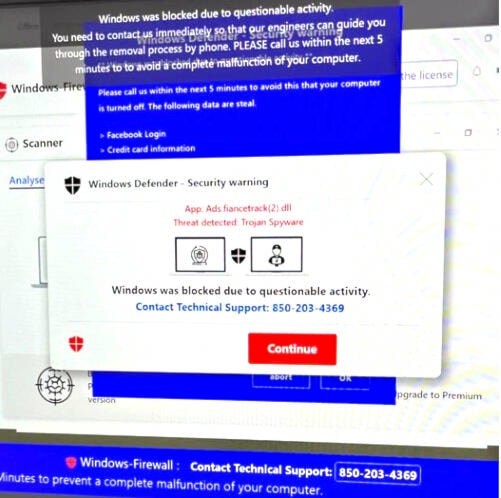So you’re browsing the Internet looking for recipes, or catching up with your family on social media, when suddenly something happens. Your computer locks up, things start flashing, a loud alarm sounds and an electronic voice may accuse you of illegal activities. It’s noisy, it’s scary, and maybe if you call that phone number that’s on your screen you can make it go away. However calling that number is the last thing you want to do, because you’ve just encountered a tech support scam.
Tech support scams are not exactly new, but they are ever evolving. Phone based scams have been around for well over a decade, and usually involve an unsolicited phone call from someone claiming to be from Microsoft or Apple. This supposed technician would tell you your computer has a problem, and would try to convince you to download a remote access program to allow them to fix it for “free”. Once connected they try to scare their victim by showing them normal system logs or standard diagnostics as proof the computer is compromised. They make up “problems” or “security threats” and suddenly the free support they promised stops being free.
The unfortunate aftermath of these scams have left Burns Lake residents with charges of $300 to $900 for tech support or service contracts that they didn’t want or need. If they didn’t pay, victims might find it difficult to get the scammer to disconnect. Short of physically pulling the plug, they could be forced to watch helplessly as an unknown person rampaged around their computer, deleting files or threatening them until they paid up. There has been cases where the scammers were able to get into the victim’s online banking and attempted to steal money. Please, do not ever let your computer remember your online banking password.
In the last few years a new version of this scam has become increasingly popular. Website based scam advertisements turn the typical fake support call around by scaring you into calling the scammers instead. It gets a bit technical, but the scammers are exploiting vulnerabilities in online advertisements to redirect your web browser – Chrome, Edge, Firefox, Safari, etc – to go to their fake security alert website. Once there, your screen is plastered with warnings, official logos, and a phone number for tech support. If you encounter one of these scam advertisements, do not call the phone number.
To get rid of the scam ad, do the following: On a Windows computer hit Ctrl+Alt+Del and select Task Manager. Right click on your browser in the App list, select End Task, and the browser will close. On a Mac, use Option+Command+Escape to bring up the Force Quit menu. Select your browser and click on Force Quit. When you reopen the browser it may ask if you want to restore the previous session. Do not restore, or it will return to the scam ad. That should be the end of it, but if not seek out help or advice from someone you trust.
